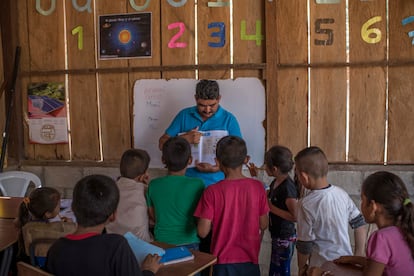Wanted: 3.2 million teachers
Latin America and the Caribbean have an enormous educational setback, and those who carry the burden are poorly paid, technologically challenged teachers with pandemic fatigue

Julio César Rodríguez Molano graduated in mathematics and computer science in Colombia, completed a master’s degree in website management and engineering and is a doctoral student in computer science from the University of Oviedo (Spain). However, his salary as a teacher in a rural Colombian school does not exceed $813. Baltazar Sánchez, director of the official mixed rural school of Aldea Juil, in Guatemala, earns less than $900. Darío Greni Olivieri, in Uruguay, receives $1,300.
Although the cost of living and the salaries vary greatly between the different Latin American countries (ranging from $300 to $1,500), most teachers have lower wages than people from other careers that require similar years of training. And passion does not put bread on the table. “The prices of the essential goods are sky-high, and our salaries cannot keep up. We are professionals, and we can’t always make ends meet,” says Sánchez. “I should be earning $370 more; the difference is due to the government’s obstacles to promotion. My salary is not enough,” says Rodríguez.
According to estimates by the UNESCO Institute for Statistics, published last Wednesday in the context of World Teachers’ Day, there is a global shortage of 44 million teachers. Some of the reasons are job insecurity, the lack of government support, little or no digitalization and obsolete infrastructure. At least 3.2 million are needed in Latin America and the Caribbean to achieve the educational goals of the 2030 Agenda.
Twenty years ago, this unmet demand was linked to an increase in school enrollment. Today, it has more to do with the difficulty of attracting candidates or keeping them in their jobs. Claudia Uribe, director of the UNESCO Regional Bureau for Education in Latin America and the Caribbean, is very concerned about desertion in the sector: “This rate among primary school teachers has doubled in seven years. In 2015, it was 4.62% and, in 2022, 9.06%.” According to regional estimates, most of the teacher shortage expected for 2030 is attributed to the potential need to fill existing positions.
When personnel are in such demand, explains Bibiam Díaz, education specialist at the CAF Development Bank of Latin America and the Caribbean, the requirements are not so strict. This has a notable impact on the performance of many teachers and students. “We are facing a great challenge in the continent regarding teacher training, especially in the digital area. Although it is true that the different countries are making progress in this sense, they often go through the process of adapting to artificial intelligence or technology alone, in their free time,” she explains. This is the case of Greni, director and teacher of the rural school number 88 in Las Violetas, Uruguay, who estimates that he devotes an average of 10 extra hours a week to prepare his classes and train.
Although Uruguay has been praised for its famous Ceibal Plan, which provided tablets and computers and incorporated digital tools throughout the educational process, adaptation to technological reality is still slow. “We have not received any courses on artificial intelligence yet. I think we could really benefit from it, but I haven’t ventured into it with my students because I think I need training. We don’t have it yet.” For rural teachers like Rodríguez, the gaps are even wider: “Although governmental organizations constantly offer us courses on emerging technologies, they are difficult to apply because they are concentrated in training institutions that are located in large populated areas.”
Díaz insists: “A lot can be improved in the way the teaching career is designed, but also in the role of the governments so [the teachers] won’t be left alone.” Solitude at work increased during the Covid-19 crisis. The teachers did not want to know about schedules or medical restrictions if that meant weariness or hopelessness among the students. Despite their efforts, Latin America took more than a year and a half to return to in-person learning, and the setback in student learning was equal to a decade. In addition, nearly 15 million children left school after the pandemic. Greni questioned many times if anybody was thinking about the well-being of the teachers. And Sánchez, in Guatemala, says he is still suffering the consequences of the hiatus: “We are only starting to recover.”
Although teaching is a highly feminized career (73%), those who leave are usually men who are either at the very beginning or near the end of their careers, working in schools with a high level of vulnerability. UNESCO data shows that after the pandemic, teacher dropout rates increased considerably at primary levels. The scarcity also seems to affect certain disciplines, such as mathematics and science, as well as schools that are more vulnerable or of Indigenous origin.

“More practical training is necessary”
But what can change the training of teachers in the education system? Verónica Cabezas, executive director of Elige Educar, a public-private initiative dependent on the Chilean Ministry of Education and the Public Policy Center of the Catholic University in Spain, is clear: everything. For her, the key lies in three main points: “It is necessary to have more practical training that is closer to the territories where classes are taught, understanding the context of the students well; monitoring that does not end with the graduation of the teachers, but continues during the first year of internship; and a solid socio-emotional orientation.” She adds: “Those who study to become teachers have to know what it means to teach long before they graduate,” since in cities like Buenos Aires, for instance, only one in three teaching students graduates.
Endless hours, low salaries and a heavy workload. Although the teaching sector in the region has many things to improve, the three teachers interviewed cannot imagine doing anything else. Experts, however, point out that their calling and passion cannot be the only pillars on which such important work is supported. “Our office is a classroom full of children,” adds Grani. “Teachers have to understand that the higher quality of the educational system is a benefit for them; the students. They need to try teaching as soon as possible to know if they like it or want to give up. I am clear that I will do this until I retire.”
Sign up for our weekly newsletter to get more English-language news coverage from EL PAÍS USA Edition
Tu suscripción se está usando en otro dispositivo
¿Quieres añadir otro usuario a tu suscripción?
Si continúas leyendo en este dispositivo, no se podrá leer en el otro.
FlechaTu suscripción se está usando en otro dispositivo y solo puedes acceder a EL PAÍS desde un dispositivo a la vez.
Si quieres compartir tu cuenta, cambia tu suscripción a la modalidad Premium, así podrás añadir otro usuario. Cada uno accederá con su propia cuenta de email, lo que os permitirá personalizar vuestra experiencia en EL PAÍS.
¿Tienes una suscripción de empresa? Accede aquí para contratar más cuentas.
En el caso de no saber quién está usando tu cuenta, te recomendamos cambiar tu contraseña aquí.
Si decides continuar compartiendo tu cuenta, este mensaje se mostrará en tu dispositivo y en el de la otra persona que está usando tu cuenta de forma indefinida, afectando a tu experiencia de lectura. Puedes consultar aquí los términos y condiciones de la suscripción digital.











































